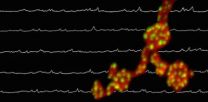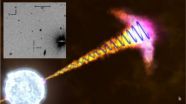(Press-News.org) BOSTON -- Blood vessel formation is critical to life and its manipulation is instrumental to a number of diseases. For more than 40 years, investigations into the structure and function of endothelial cells lining the blood vessels have revealed a complex tissue with complex functions, demonstrating that endothelial cells participate in all aspects of vascular homeostasis and pathological processes.
Today, important revelations regarding endothelial cell behavior are emerging from vascular simulation research, a blossoming interdisciplinary field that makes use of novel computational models to uncover the cellular processes and dynamic interactions that take place as arteries and veins are built.
Vascular simulation research is the focus of two recent papers coauthored by investigators in the Center for Vascular Biology Research (CVBR) at Beth Israel Deaconess Medical Center (BIDMC), one of which provides a novel explanation for the enlarged blood vessels that are seen in various pathologies, including tumors and retinopathies.
"Understanding how, when and why individual endothelial cells coordinate decisions to change shape in relation to dynamic tissue environment signals is key to understanding normal and abnormal blood vessel growth," says Katie Bentley, PhD, Group Leader of the Computational Biology Laboratory in the CVBR and Assistant Professor of Pathology at Harvard Medical School. "Such insights could, for example, prove valuable in the treatment of cancer, which relies on a constant supply of blood to support tumor growth and cancerous spread."
Adaptive systems research brings things into focus
Bentley's computational modeling derives from training in Adaptive Systems research, an interdisciplinary field aimed at elucidating the fundamental organizing principles of living systems through the combined use of simulation, robotics and experimental models. Her work focuses on the construction of simulated (Simulant) endothelial cells, capable of generating novel, unexpected behavior, including movement, shape and signaling changes.
"Simulants can be observed individually and as an interacting social collective – recapitulating a growing blood vessel, for example," she explains. "We can tinker with how we set up their internal workings and then compare the changes this causes in model behavior to real cell behaviors in order to make predictions on how the mechanisms work in real cells."
Together with CVBR investigator Erzsebet Ravasz Regan, PhD, and Andrew Philippides, PhD, of the University of Sussex, UK, Bentley recently published a review article in the April 28 issue of Developmental Cell, which examines the growing field of computer simulations in vascular biology and focuses on providing an accessible account of the illuminating principles and toolsets of the Adaptive Systems field for the cell biology community.
"The Adaptive Systems field traditionally draws on animal/insect behavior and cognition to derive general principles and inspire better robotics capable of intelligent, adaptive behavior," says Bentley. "But we wanted to highlight that it can also be a very useful perspective and mindset to approach cell biology, in other words, to understand single to collective cell behavior in complex systems, such as blood vessel growth. The approach offers useful principles for studying a wide variety of questions about health and disease."
Simulant cells' unexpected behavior reveals new in vivo mechanisms
Using this type of collaborative computational and experimental approach, Bentley and a research team from the laboratory of Holger Gerhardt, PhD, of Cancer Research UK's London Research Institute recently made an unexpected discovery about endothelial cell behavior during angiogenesis. In a study published last month in Nature Cell Biology, they showed that sprouting cells are in a continuum of migratory states, regulated by differential cell-cell adhesions and protrusive activities that drive proper vascular organization.
During blood vessel formation, certain molecules and cues tell endothelial cells to take on different characteristics, with some becoming "polarized tip cells" and other becoming "stalk cells." Together these two cell types form new capillaries. Tip and stalk cells were previously thought to have established roles, with tip cells leading the way and stalk cells following along to create a vessel tube, but recent research has suggested that endothelial cells are much more spontaneous and actually undergo dynamic changes and frequently switch positions, with stalk cells overtaking tip cells at the leading edge of a new blood vessel.
Previous studies of endothelial rearrangements suggested the adhesion molecule VE-cadherin plays a key role in helping endothelial cells to stick together. "Our team had linked rearranging behavior of endothelial cells during vessel sprouting to a signaling pathway called Notch," explains Bentley. "But what Notch regulates to generate movement and how it may interplay with VE-cadherin has remained elusive. It's also been unclear how pathological conditions such as cancer may affect the rearrangement process or whether rearrangement defects may contribute to disease."
Bentley and Gerhardt propose that when endothelial cells are stimulated by vascular endothelial growth factor (VEGF) -- and not inhibited by Notch signaling – they are "active" and can either form a new branch as tip cells or "shuffle up" through the existing sprout by cell rearrangement mechanisms. Their new work in Nature Cell Biology validated simulation predictions in vivo, demonstrating that Notch regulates shuffling movement via VE-cadherin adhesion.
"We identified that feedback regulation between VEGF and Notch signaling results in different levels of adhesion [through VE-cadherin] and junctional cortex movements between cells in the sprout, which actually drives the cell rearrangement and tip cell competition," says Bentley. The team also found that during cancer development and progression, there is a switch: the regulation of the adhesion between cells becomes more uniform so that there are clustered regions of cells in an all-active or all-inhibited shuffling state.
"When we let Simulant cells loose in a simple simulated tumor environment, their collective behavior changed dramatically," says Bentley. "The cells go through cyclic phases of adhesion and junctional movements now as a group, in which they all clamber to move at once or all remain still. In either case they are getting nowhere as overtaking requires differential movement of one cell compared to its neighbors. The disrupted rearrangement provides a new explanation for the enlarged blood vessels we see in pathologies, such as in mouse models of tumors or retinopathies."
This research approach offers useful new principles for studying basic and complex questions about health and disease. "We hope that our work provides an example that cell level theory can be made accessible and, when integrated with experimentation, can help us unravel the complexities and dynamics of living systems and disease," adds Bentley.
INFORMATION:
Beth Israel Deaconess Medical Center is a patient care, teaching and research affiliate of Harvard Medical School, and currently ranks third in National Institutes of Health funding among independent hospitals nationwide.
The BIDMC health care team includes Beth Israel Deaconess Hospital-Milton, Beth Israel Deaconess Hospital-Needham, Beth Israel Deaconess Hospital-Plymouth, Anna Jaques Hospital, Cambridge Health Alliance, Lawrence General Hospital, Signature Health Care, Commonwealth Hematology-Oncology, Beth Israel Deaconess HealthCare, Community Care Alliance, and Atrius Health. BIDMC is also clinically affiliated with the Joslin Diabetes Center and Hebrew Senior Life and is a research partner of Dana-Farber/Harvard Cancer Center. BIDMC is the official hospital of the Boston Red Sox. For more information, visit http://www.bidmc.org.
Vascular simulation research reveals new mechanism that switches in disease
2014-05-07
ELSE PRESS RELEASES FROM THIS DATE:
Airborne measurements confirm leaks from oil and gas operations
2014-05-07
During two days of intensive airborne measurements, oil and gas operations in Colorado's Front Range leaked nearly three times as much methane, a greenhouse gas, as predicted based on inventory estimates, and seven times as much benzene, a regulated air toxic. Emissions of other chemicals that contribute to summertime ozone pollution were about twice as high as estimates, according to the new paper, accepted for publication in the American Geophysical Union's Journal of Geophysical Research: Atmospheres.
"These discrepancies are substantial," said lead author Gabrielle ...
Astronomers create first realistic virtual universe
2014-05-07
Move over, Matrix - astronomers have done you one better. They have created the first realistic virtual universe using a computer simulation called "Illustris." Illustris can recreate 13 billion years of cosmic evolution in a cube 350 million light-years on a side with unprecedented resolution.
"Until now, no single simulation was able to reproduce the universe on both large and small scales simultaneously," says lead author Mark Vogelsberger (MIT/Harvard-Smithsonian Center for Astrophysics), who conducted the work in collaboration with researchers at several institutions, ...
Brain noise found to nurture synapses
2014-05-07
NEW YORK, NY (May 7, 2014) — A study has shown that a long-overlooked form of neuron-to-neuron communication called miniature neurotransmission plays an essential role in the development of synapses, the regions where nerve impulses are transmitted and received. The findings, made in fruit flies, raise the possibility that abnormalities in miniature neurotransmission may contribute to neurodevelopmental diseases. The findings, by researchers at Columbia University Medical Center (CUMC), were published today in the online edition of the journal Neuron.
The primary way ...
Native algae species to blame for 'rock snot' blooms in rivers worldwide
2014-05-07
VIDEO:
The recent appearance of the freshwater algae known as "rock snot " on river bottoms worldwide is caused by a native species responding to changing environmental conditions rather than by accidental...
Click here for more information.
The recent blooms of the freshwater algae known as "rock snot" on river bottoms worldwide are caused by a native species responding to changing environmental conditions rather than by accidental introductions by fishermen or the ...
Early depression, anger may taint love life even 20 years later, study shows
2014-05-07
A University of Alberta study is helping crack the code to happiness by exploring the long reach of depression and anger over more than two decades.
The study, published recently in the Journal of Family Psychology, followed 341 people for 25 years, and found that negative emotions they may have suffered as young adults can have a lasting grip on their couple relationships, well into middle age.
The fact that depression and anger experienced during the teen years clung to people, even through major life events such as child-rearing, marriages and careers was surprising, ...
Community doulas can be a big help for mother-baby relationships
2014-05-07
Young mothers are more likely to breastfeed and have positive relationships with their babies when they have another woman "mothering" them in the delivery room, according to new research at the University of Chicago on the value of doulas—women who help with deliveries and early care for mothers and babies.
The assistance from doulas is particularly valuable to young mothers from disadvantaged backgrounds. Those mothers sometimes receive help from women known as community doulas, who are from similar backgrounds as the young women and who visit them weekly for several ...
Emerald ash borers were in US long before first detection
2014-05-07
EAST LANSING, Mich. — New research at Michigan State University shows that the uber-destructive emerald ash borer arrived at least 10 years before it was first identified in North America.
The study, published in the current issue of journal Diversity and Distributions, shows that EABs were feasting on ash trees in southeast Michigan by the early 1990s, well before this pest was discovered in 2002, said Deb McCullough, MSU professor of forest entomology.
"We suspect they arrived inside wood crating or pallets imported from Asia where the beetle is native," she said. ...
Clues about black hole formation
2014-05-07
This news release is available in Spanish.
The work, which has had the participation of the Ikerbasque researcher Javier Gorosabal, co-director of the Associated Unit with the Institute of Astrophysics of Andalusia/CSIC-UPV/EHU, has been published in the prestigious journal Nature.
There is no other event in the cosmos that can compete in terms of energy and intensity with stellar explosions on the outer reaches of the universe and which are known as LGRBs (Long Gamma-Ray Bursts): in just one second a single GRB can emit as many as hundreds of stars like the Sun ...
How businesses can maximize revenue when introducing new products
2014-05-07
BUFFALO, N.Y. — Companies should use existing brand names and add new, sub-brand names to maximize revenue when introducing new products to market, according to a new study from the University at Buffalo School of Management.
Forthcoming in Management Science, the study notes a proliferation of new products in the consumer packaged-goods market each year. For example, U.S. manufacturers introduced more than 150,000 new products in 2010 alone. Of these, more than 90 percent were extensions of existing brand-name products.
"These new products can be line extensions, like ...
Regular doctor visits may greatly diminish skin cancer deaths
2014-05-07
VIDEO:
Melody Eide, M.D., M.P.H., a Henry Ford Hospital dermatologist and the study's lead author, says regular visits to the doctor may lead to significant reductions in melanoma mortality....
Click here for more information.
DETROIT – The risk of dying from the most dangerous type of skin cancer is significantly reduced with regular doctor visits, according to a Henry Ford Hospital study.
This is believed to be the first study of its kind to link melanoma mortality with ...




